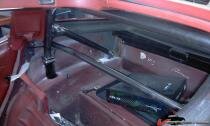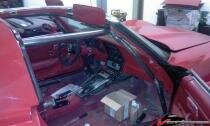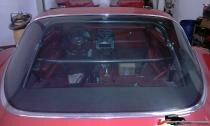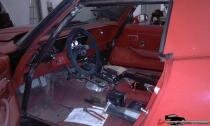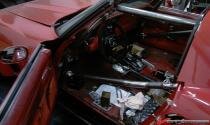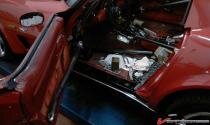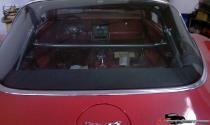This is from the SCCA Solo rule book.
APPENDIX C - SOLO ROLL BAR STANDARDS
A. BASIC DESIGN CONSIDERATIONS
1. The basic purpose of the roll bar is to protect the driver in case
the vehicle rolls over. This purpose should not be forgotten.
2. The top of the roll bar shall not be below the top of the driver's
helmet when the driver is in normal driving position, and shall
not be more than six inches behind the driver. It is strongly
suggested that the roll bar extend at least three inches above
the driver's helmet. In case of two driver cars, both drivers
must be within the roll bar height requirement, however only
one driver must be within six inches of the roll bar. In a closed
car equipped with a roll bar/cage, it must be as close as possible
to the interior top of the car.
3. The roll bar must be designed to withstand compression forces
resulting from the weight of the car coming down on the roll
structure, and to take fore-and-aft loads resulting from the car
skidding along the ground on the roll structure.
4. The two vertical members forming the sides of the hoop shall
not be less than fifteen inches apart (inside dimension). It is
desirable that the roll bar extend the full width of the cockpit
to provide maximum bearing area in all soil conditions during
rollovers. The roll bar vertical members on formula cars and
other single seat cars with a center driver position must be not
less than fifteen inches apart, inside dimension, at their attachment
points to the uppermost main chassis member.
5. An inspection hole of at least 3/16 inch diameter must be
drilled in a non-critical area of a roll bar member to facilitate
verification of wall thickness. This should be at least three
inches from any weld or bend.
6. It is recommended that steel gusset plates be used at all
welds. Gussets should be at least two inches long on each leg
and 3/16 inches thick.
7. It is recommended that roll bars be coated only with a light
coat of paint. If, however, a roll bar should be chrome-plated,
it is recommended that the structure be normalized.
8. Post or tripod types of roll bars are not acceptable.
B. MATERIAL
After 9-22-85, aluminum is not an acceptable alternate material.
Cars using aluminum roll bars or roll cages must file proof with
the SD that the structure was approved prior to 9-22-85 as provided
in this section.
1. The roll bar hoop and all braces must be of seamless, ERW, or
218
DOM mild steel tubing (SAE 1010, 1020, 1025) or equivalent,
or alloy steel tubing (SAE 4130). It is strongly recommended
that roll bars not be constructed of ERW due to quality and
strength concerns.
2. The size of tubing to be used shall be determined on the
basis of the weight and speed potential of the car. The following
minimum sizes are required required and are based
upon the weight of the car without the driver.
a) Over 1500 lbs.-min. of 1-1/" 2 o.d. x .120" wall or 1-3/4"
o.d. x .095" wall
b) Over 1000 lbs.-min. of 1-1/4" o.d. x .090" wall
c) Under 1000 lbs.-min. of 1" o.d. x .060" wall
Dimensions are nominal. 0.005" variation in wall thickness is
allowed.
3. Each mounting plate shall be at least .080" thick if welded and
3/16" thick if bolted. A minimum of 3 bolts per plate is required
for bolted mounting plates.
4. All bolts and nuts shall be SAE Grade 5 or better, 5/16"
minimum diameter.
C. FABRICATION
1. One continuous length of tubing must be used for the hoop
member with smooth continuous bends and no evidence of
crimping or wall failure.
2. All welding must be of the highest possible quality with full
penetration and will be subjected to very critical inspection.
Arc welding, particularly heliarc, should be used wherever
possible.
D. BRACING
1. It is recommended that braces be of the same size tubing as
used for the roll bar itself.
2. All roll bars must be braced in a manner to prevent movement
in a fore-and-aft direction with the brace attached
within the top one-third of the roll hoop, and at an angle of at
least thirty degrees from vertical. It is strongly recommended
that two such braces be used, parallel to the sides of the car,
and placed at the outer extremities of the roll bar hoop. Such
braces should extend to the rear whenever possible.
3. It is suggested that roll bars include a transverse brace from
the bottom of the hoop on one side to the top of the hoop on
the other side.
219
E. MOUNTING PLATES
1. Roll bars and braces must be attached to the frame of the car
wherever possible. Mounting plates may be used for this
purpose where desired.
2. In the case of cars with unitized or frameless construction,
mounting plates may be used to secure the roll bar structure
to the floor of the car. The important consideration is that the
load be distributed over as large an area as possible. A
backup plate of equal size and thickness must be used on the
opposite side of the panel with the plates through-bolted
together.
F. REMOVABLE ROLL BARS
Removable roll bars and braces must be very carefully designed
and constructed to be at least as strong as a permanent installation.
If one tube fits inside another tube to facilitate removal, the
removable portion must bottom on the permanent mounting,
and at least two bolts must be used to secure each such joint.
The telescope section must be at least eight inches in length.
G. INSTALLATION ON CARS OF SPACE FRAME AND FRAMELESS
DESIGN
1. It is important that roll bar structures be attached to cars in
such a way as to spread the loads over a wide area. It is not
sufficient to simply attach the roll bar to a single tube or junction
of tubes. The roll bar must be designed in such a way as
to be an extension of the frame itself, not simply an attachment
to the frame. Considerable care must be used to add as
necessary to the frame structure itself in such a way as to
properly distribute the loads. It is not true that a roll bar can
only be as strong as any single tube in the frame.
H. ROLL CAGES
It is recommended but not mandatory that all cars utilize a roll
cage as defined in Section 18 of the GCR.
I. ROLL BAR PADDING
Braces and portions of the main hoop subject to contact by
the driver's or passenger's helmet, as seated normally and restrained
by seatbelt and harness, must be padded with a nonresilient
material such as Ethafoam (R) or Ensolite (R) or other
similar material with a minimum thickness of one-half inch.
